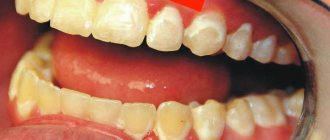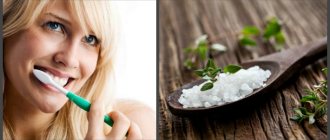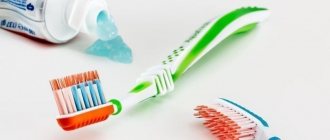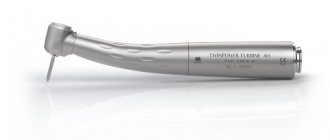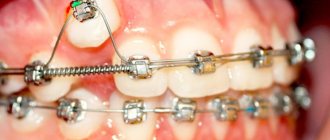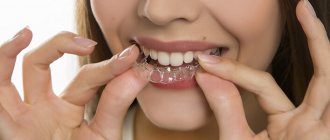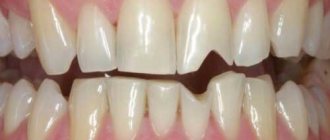Teeth whitening in childhood – how safe and justified?
When a child’s tooth enamel begins to darken, this may indicate insufficient oral hygiene or the development of a dental disease. But teeth can change color for other reasons beyond our control, for example, as a result of genetic predisposition. Due to such circumstances, the child may develop psychological complexes and self-doubt. Therefore, some parents have a completely reasonable question: is it possible to whiten children’s teeth and how safe is it? You will find answers to these and other questions later in this article.
Is it possible to whiten teeth as a child?
Is it painful to whiten teeth?
Any whitening technique cannot be called painless. The degree of discomfort depends on a number of factors:
- whitening technique;
- degree of enamel damage;
- the presence of foci of inflammation in the gum area;
- level of professionalism of the dentist.
The safest methods include professional cleaning with ultrasound or the Air-Flow method. Using this technique, the dentist will remove plaque and tartar, the crowns will acquire a natural color, 1-2 shades lighter. The procedure is carried out using a local anesthetic and, with healthy gums, is painless. If the gums are inflamed and the enamel is thinned, the pain will be much more pronounced.
All whitening methods based on the use of hydrogen peroxide are accompanied by increased sensitivity due to demineralization and unpleasant sensations. If the peroxide gel gets on the gums, it will cause pain and may cause a burn.
To avoid unpleasant sensations, whiten your teeth only in trusted clinics and do not overuse the procedure. A good dentist will take care of the health of your teeth and gums, which will reduce the likelihood of severe pain. Patients with a high pain threshold are recommended to take a painkiller 30-40 minutes before the session.
Why does a child's teeth darken?
Tooth enamel can darken for various reasons. At the same time, it can noticeably turn yellow or even turn light brown. Of course, this state of affairs can negatively affect not only oral health, but also the psychological state of the child. So why does enamel change color? Here are some common reasons for this unpleasant phenomenon:
- uncontrolled consumption of sweets and fast carbohydrates: foods high in sugar are the most common cause of the development of caries in childhood1. They contribute to the formation of a bacterial film on the surface of the enamel, which very quickly turns into hard dental deposits. All this leads to its inevitable darkening,
Caries leads to discoloration of teeth - constant consumption of food with pigments: this includes coloring drinks such as tea, coffee, sweet soda with dyes. The latter not only contribute to a change in the color of the enamel, but also lead to the gradual destruction of dental tissues, since the composition of such liquids contains too many sugars and acids,
- genetics: according to experts, quite often dark enamel becomes a consequence of genetic predisposition, and then dealing with the problem becomes much more difficult,
- tooth injury: the presence of microcracks, scratches, chips, carious plaque and dental deposits on the enamel - all these factors have a direct impact on the condition and, accordingly, the color of the enamel.
“When my child’s teeth became very dark, I immediately decided that he wasn’t brushing. I started urging him to brush his teeth in front of me every morning and evening before bed. I excluded sugar and flour from my diet, of course, as much as possible. But nothing helped. And only at the dentist’s appointment it turned out that it was all a matter of genetics. The teeth themselves are very susceptible to caries, and even dark. We were booked in for professional cleaning, but were told to hold off on bleaching. Such procedures are not performed on children, so they will have to wait until they reach adulthood.”
Alyonka_33, Omsk, from correspondence on the woman.ru forum
Keep in mind that if there is even the slightest damage to tooth enamel, it is prohibited to use any whitening methods, especially at home. Otherwise, the aggressive effects of whitening agents may even lead to complete destruction of the outer protective layer of the teeth. Therefore, before carrying out such a procedure, it is imperative to consult with a specialist.
Important! As for children, it is generally not allowed to use any methods of lightening enamel without the permission of the dentist. Therefore, the answer to the question “is it possible to whiten teeth in childhood” will, on the one hand, be categorical (the use of chemicals is prohibited), but, on the other hand, it will be positive – there is a professional cleaning method.
What is needed before the procedure: general recommendations for strengthening enamel
Before the procedure, you need to prepare. During the consultation, the doctor will give individual recommendations, but there are general rules:
- Whitening uses chemical reagents that penetrate inside the tooth, eliminating pigmentation. If there is soft plaque or tartar, it is recommended to have your teeth professionally cleaned , otherwise their color will be uneven after whitening.
Photo 2. The process of professional teeth cleaning. The doctor acts on the enamel with a special eraser. - In case of inflammation of the gums, they will require treatment . Bleaching is allowed after several days after complete healing and normalization of the condition.
- You should avoid fluoridation of teeth before the lightening procedure , since fluoride covers their surface with a film and prevents the penetration of lightening agents, the desired effect will not be achieved.
- Treatment of caries is mandatory, otherwise the procedure will be extremely painful . In addition, aggressive reagents of lightening gels, getting into existing cavities, will accelerate tooth decay.
Attention! After bleaching, you should not eat dyed foods for a week.
Lightening causes the destruction of mineral substances in tooth enamel, so after the procedure it is recommended to restore it - remineralization.
Professional hygiene complex - an option on how to make children's tooth enamel lighter
So, is it possible to whiten a child’s teeth and how to do it without damaging the fragile enamel? In fact, what we usually mean by bleaching, that is, the use of aggressive chemicals, is contraindicated in children. This raises a logical question: at what age can one begin to carry out such procedures? In dental centers, this type of service is offered to patients only from 15-16 years of age, and in some situations even from 18 years of age. However, there is another, alternative option - regular, but very high-quality teeth cleaning. Let's look at this method.
So, in addition to classic whitening (photo, chemical or laser), modern dentistry offers the opportunity to steal electrical energy to clean the enamel of plaque and plaque in a gentle way. Using hardware techniques, you can lighten your teeth a couple of shades, but if the cause of dark enamel is genetics, this method is unlikely to make it noticeably lighter. On the other hand, this is not just effective, but mandatory prevention of caries development, which is carried out for children starting from 7-8 years old and even younger. When a very young patient finds himself in the dental chair, he may be offered gentle manual cleaning.
In childhood, only gentle brushing of teeth is allowed.
Cleaning using the Air Flow device has become widespread today. In this case, we are not talking about an aggressive chemical effect, but about high-quality cleansing of the enamel from bacteria and accumulations of food debris. The device works as follows: compressed air is supplied to the tip under high pressure along with baking soda. Treatment of the surface of the teeth with a powerful jet allows you to clean even the most inaccessible places. In order to give the effect of freshness, essential oil or lemon essence is often added to the mixture.
On a note! Ultrasonic cleaning before the age of 5-7 years is also prohibited. Air Flo cannot be used if the child has a hypersensitivity to citrus fruits or mint - there is a high risk of developing an allergic reaction.
What causes tooth sensitivity: main reasons
Tooth sensitivity (hyperesthesia) significantly impairs a person’s quality of life. He constantly experiences unpleasant sensations and discomfort when his teeth are exposed to cold or hot temperatures, sweet or sour foods.
What causes this condition? The main factors that increase tooth sensitivity are the following:
- the formation of cracks and chips on tooth enamel increases the sensitivity of the tooth if appropriate treatment is not carried out;
- Improper brushing of teeth increases the risk of developing sensitivity. For example, sudden movements with a brush lead to thinning of the enamel layer, which in turn weakens the dentin;
- when gums recede, tooth roots are exposed, which significantly increases the teeth’s susceptibility to external influences;
- the age factor influences hyperesthesia. The most sensitive teeth are in people aged 25-30 years. During this period, careful and careful handling of teeth is necessary.
Another reason for excessive tooth sensitivity is genetic predisposition.
Is it possible to whiten sensitive teeth? Such procedures are not contraindicated; they just need to be carried out using special means and using the most gentle methods possible.
Why classic whitening is not performed in childhood
So what’s wrong with classic professional whitening and why aren’t similar procedures performed in children? The thing is that a child’s tooth enamel is characterized by increased fragility and susceptibility to any kind of external irritants. And traditional methods of lightening it precisely involve a rather aggressive effect on the surface of the teeth. Here are some good reasons that do not allow you to whiten children's enamel even in the dentist's office:
- thinning of the enamel: as a result of exposure to chemicals, ultraviolet radiation or laser, the density of the enamel is noticeably reduced and its structure is disrupted. When it comes to a child, the protective layer of the teeth may not be able to withstand it at all. As a result, the risk of developing caries and other dental diseases greatly increases,
- demineralization: during the procedure, rapid destruction of minerals is observed, and this, in turn, greatly weakens the teeth. Even adult patients after whitening are recommended to undergo a remineralization procedure,
- increased enamel sensitivity: teeth begin to react sharply to hot and cold, as well as to acidic foods, and this is an obvious drawback of professional whitening. The enamel becomes much thinner, which significantly increases the likelihood of problems with teeth and enamel pigmentation in particular.
- risk of burns: using ultraviolet light to lighten tooth enamel can cause a serious burn on the mucous membrane. At the same time, dental tissues also suffer greatly from heating.
Aggressive whitening can lead to thinning and demineralization of the enamel.
Obviously, the only option to make the enamel of children's teeth a little lighter is to schedule a professional cleaning at the dentist's office. If we are talking about a child, then this is the safest and preferable option, which allows you to make the enamel a couple of tones lighter. And remember: independent attempts to lighten children’s teeth using folk remedies are fraught with serious problems, including complete destruction of the enamel. This kind of procedure is best left to professionals.
- According to WHO research results.
Is it possible to do whitening during pregnancy and breastfeeding?
Doctors do not recommend lightening during these periods, since no studies have been conducted on the effects of teeth whitening on the health of women in such conditions. the ultrasonic method can be used , which does not involve the use of aggressive chemicals and is considered safe.
Ultrasound allows you to eliminate tartar and plaque without damaging the enamel and carefully cleans the surface and has an antibacterial effect. The color is lightened by two to three tones.
Ultrasonic whitening is carried out with a special device equipped with a nozzle through which the dentist regulates the supply of a mixture of water, air and fine powder based on soda or chalk.
Important! This procedure preserves the integrity and healthy state of the enamel and allows you to remove dental plaque not only from the surface, but also those located under the gums.
In fact, the procedure is a professional teeth cleaning , since the effect is on the surface layers. Before whitening, the dentist must examine the patient and, if necessary, perform oral sanitation. The presence of caries or pulpitis can cause pain during ultrasonic teeth whitening.
The decision to carry out whitening during pregnancy and breastfeeding should be made together with a doctor after a thorough analysis of the possible negative consequences for the woman’s health.
Pros and cons of ZOOM 4 whitening
ZOOM 4
Advantages of this technique:
- guaranteed enamel lightening by 8-10 tones;
- long-term effect - with proper daily hygiene and a balanced diet, teeth begin to darken no earlier than after 4 years;
- the session lasts 45 minutes, which is 30% faster than the previous generation devices;
- the upper layers of enamel are not destroyed, as with chemical bleaching;
- clinically proven results in patients with advanced fluorosis and tetracycline teeth;
- The device's lamp has a cold halogen light, the risk of gum burns is minimal.
There are not many disadvantages to the procedure:
- an impressive list of contraindications;
- slight likelihood of increased tooth sensitivity after the session;
- if anterior fillings and dentures are installed, they will have to be changed to lighter ones so that they do not stand out;
- high cost of the service.
Contraindications
Both professional and home whitening of sensitive teeth is contraindicated in the following cases:
- if there are cracks or chips in the enamel;
- with carious damage to teeth;
- if the seal fits poorly, whitening will only increase tooth sensitivity;
- if you are allergic to bleaching components and in particular to hydrogen peroxide;
- for periodontal disease and other types of dental diseases.
A relative contraindication is pregnancy and breastfeeding. Such procedures are prohibited for children and adolescents under 16 years of age.
Indications and contraindications for ZOOM 4 whitening
Whitening ZOOM 4
This procedure is usually used for the same reasons as other whitening procedures:
- dissatisfaction with the natural shade in the smile area;
- smoker's pigmented coating is a consequence of many years of addiction;
- restoration of uniform color of teeth after braces.
Contraindications to this procedure are also traditional:
- age up to 16 years;
- oncological diseases;
- inflammation of the oral cavity in the acute stage;
- untreated caries;
- regular use of antibiotics and oral contraceptives;
- epilepsy and other neurological disorders;
- allergy to the components of the whitening gel.
Do not forget that ZOOM 4 whitening is a purely cosmetic procedure. Before signing up for a session, you must undergo an examination by a dentist, cure all diseases of the teeth and gums, so as not to provoke complications.
Change of bite in children - what is it?
A changeable bite is the condition of a child's jaw when his baby teeth are replaced by permanent teeth. A formed primary bite is 20 temporary teeth that erupted in a baby between six months and 3 years. They are gradually replaced by indigenous ones (with normal development, complete replacement occurs by 13–14 years). 8–12 chewing teeth also appear, which erupt as permanent teeth immediately.
During the period of change of occlusion, the roots of baby teeth dissolve, preparing a place for new, already permanent teeth. The change in bite begins at the age of 6 and lasts for the next 8 years. The sequence of teeth change is the same for all children, but the boundaries of the periods may vary.
The front milk teeth are the first to be renewed - just remember the photographs of first-graders on school rulers! At this time, children's jaws are actively growing, and gaps appear between the teeth necessary to freely accommodate molars - they are always larger than baby teeth. Constant changes in the structure of the jaw will occur in a child until he is 14 years old - by this time a permanent bite is established.
The formation of a bite is a very long and important process, on which the health and appearance of the child in the future largely depends. Therefore, it is necessary that the child be examined annually by an orthodontist from 6 to 14 years of age. He will make sure that the teeth are correctly positioned in the dental arch, and will also observe their size, shape, and enamel features.
It is much easier to track bite deviations in childhood or adolescence than to correct them when the child grows up.
How to teach a child to brush their teeth
The variety of oral care products today is so great that teaching a child about dental hygiene has become easier than before. You will need to supervise the process of brushing teeth until about eleven years of age - until the child develops hand motor skills.
Buy your child a beautiful toothbrush - for example, with characters from his favorite cartoons. Find a “delicious” pasta - let him choose the one he likes best. This way, the child will develop pleasant associations associated with brushing his teeth. Brush your teeth together, leading by example and turning the process into a game. Praise your child for how well he does.
Oral-B Vitality Kids Frozen D100.413.2K
Oral-B Pro 2 Junior Sensi Star Wars D501.513.2
Philips Sonicare For Kids HX6322/04 (HX6392/02)
Xiaomi Soocas Kids C1
Make sure you spend at least two minutes brushing your teeth by placing an hourglass on the sink or using a toothbrush with a built-in timer.
Plaque indicators will be a good and interesting prevention tool for a child. These are tablets and liquids that color plaque in bright colors. This way, you can understand which areas need special attention when brushing and whether it’s time to contact a specialist, and the child will have a lot of fun looking at his multi-colored teeth. And he will probably want to repeat it!
miradent Plaque Agent Plaque Indicator Rinse
Curaprox PCA 223 plaque indicator tablets
miradent Mira-2-Ton Plaque Indicator
miradent Plaque Check dental mirror
Take your child to a dental hygienist - clinics tell you well and clearly about how to care for your teeth and what will happen if you don’t. In addition, children are often motivated by themed cartoons. Show that you can take care of your teeth with pleasure - and the child will do it without unnecessary coercion.
